
周知のとおり、昨今の社会環境はテクノロジーの進歩などを背景として、大きな変革期を迎えています。ビジネスにおけるニーズも刻一刻と変化するなか、各企業に求められているのが、迅速かつ効果的な製品・サービスの開発や改善、提供までのリードタイム短縮などです。
そして、その実現にあたって世界的に注目されているのが、ビジネスサイドの利用者とITサイドの開発者をつなぎ、アジャイルプロセスにも対応している「ローコード開発」です。
このたびマクニカでは、世界をリードしているローコード開発プラットフォーム「Mendix」を提供しているSiemens社の方々をお招きし、ラウンドテーブル形式でのディスカッションを実施しました。
本記事では、Siemensに入社した年月が同じで、「Mendixの双子」と呼ばれているDanny Roest氏(以下、Danny)とTarig Elomari氏(以下、Tarig)による、Mendixの強みや事例などの講演内容をお届けします。
※本記事では通訳が英語から翻訳した、日本語の内容を掲載しています。
登壇者プロフィール
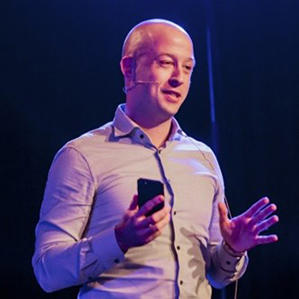
Danny Roest氏
Danny氏はコンピューター サイエンスを専攻後、コンサルタント、ソフトウェア アーキテクトのキャリアを積んできました。
Mendix入社後、エキスパート サービスのテクニカル コンサルタントとしてスタートし、1 年後にフロントエンドのプロダクト マネージャーに就任しました。ネイティブ モバイル、PWA、AR、およびいくつかの UI 構築の改善を立ち上げました。
2年間、Studio Pro とランタイムを含むアプリ開発でプロダクト マネージャーのチームを率いています。
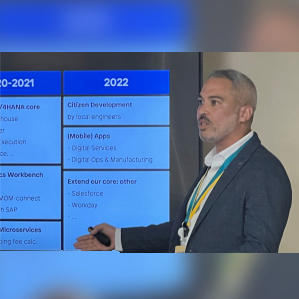
Tarig Elomari氏
Tarig氏は英国で複数の Mendix プロジェクトを成功させた後、2020年にシンガポールに移り、APAC での Mendix の成長をサポートしました。また、かつてMendix を使用し、財務会計の教育に役立つボード ゲームを作成したという興味深い実績ももっています。
Mendixの背景と、ソフトウェア市場の概況
Danny:
まず、Mendixというプラットフォームが作られた経緯をお話します。Mendixの生みの親のデレック・ルースは、天才でした。彼はソフトウェア会社を立ち上げ、やがてファーストバージョンのソフトウェアをお客様に納品しました。
彼は「あらゆるテストにより、プログラムは万全だ」と思っていましたが、納品物を受け取ったお客様は「私の求めている通りには機能していない」とおっしゃいました。そこから彼はVisioを使い、「これがお客様の意図ですか?」と確認をしながら、お客様と一緒にアプリを構築し直すようになりました。これがきっかけとなり、彼はビジュアルの活用により誰もが理解をしながら開発を進められるプラットフォーム、Mendixを作ろうと決意したのです。
昨今は、イノベーションに対するソフトウェアのディマンド(需要)が非常に高まっています。しかし、実際にはITの発展スピードがこの需要に追いついておらず、多くの現場でソフトウェア開発のプロジェクトに大幅な遅延が起きています。
そんな状況のなか、私たちMendixはビジネスサイドとITサイドが共通のビジュアルランゲージを活用し、よりスピーディにソフトウェアを仕上げられるように支援をしています。その結果、非常に多くのパートナー様に Mendixをご利用いただいています。私たちは米国の大手調査会社の調査結果において、数年にわたってリーダーのポジションにいるというお墨付きをいただいています。
群雄割拠のローコード・ノーコード開発分野における、Mendixの強み
アプリケーション開発の将来像
Danny:
私たちはアプリケーションの将来はコンポーザブル(組み合わせ可能)なものになると考えており、米国の大手調査会社も同様の見解を示しています。
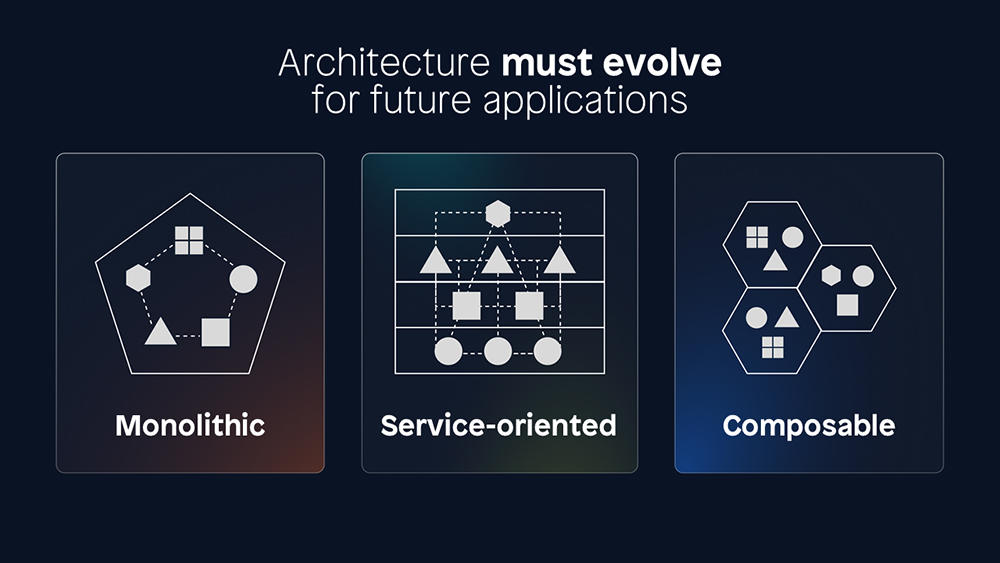
こちらは、アーキテクチャーの変遷を示したものです。左側はいわゆるモノリシックと言われるタイプのもので、いわゆるサービス主導型です。中央も同様ですが、全体に非常に複雑な要素が多くある点で異なります。そして、右側がコンポーザブルな将来を示した図です。このケースでは、たとえばCRM・ERP・アナリティクスといった色々な要素の組み合わせが考えられます。
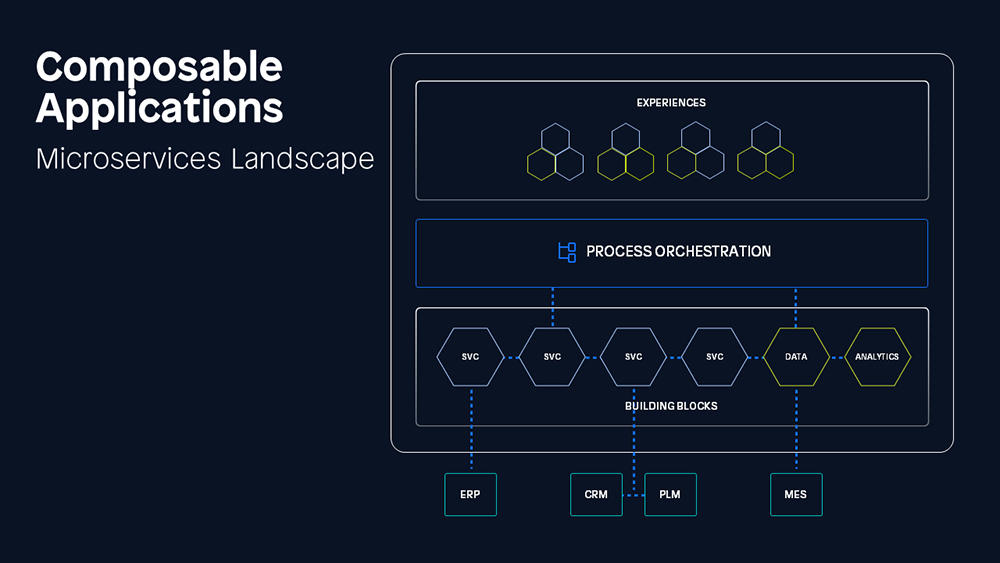
上の図はいわゆるフルスタックを表しており、アプリケーションが色々なシステムに直接結びついている、従来型の形でもあります。規模の大きなソリューションには、多くのマイクロサービスがあります。そうしたビルディングブロックおよび再利用可能な色々な要素を活用し、ユニークかつ必要とされるサービスや、エクスペリエンスを作っていくことが今後は重要になってきます。
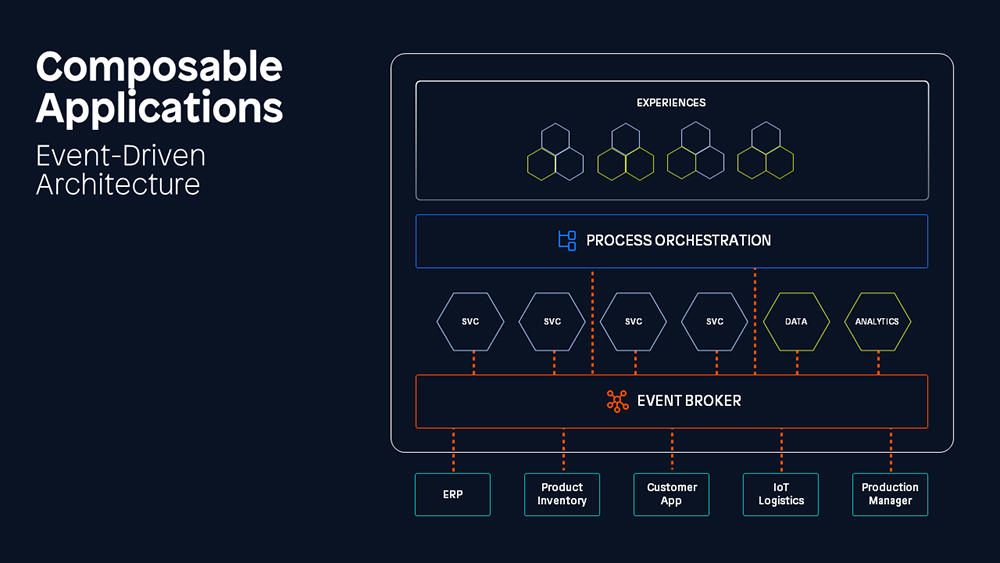
そこからさらに進めたものとして、発生した事象に対応しながら進行するイベント駆動型のアーキテクチャーもあります。また、米国の大手調査会社も提唱しているトレンドとして、AI絡みのものが挙げられます。AIを活用する場合は複数を活用し、スマートなアプリを作っていくことが求められるでしょう。
エコシステムベンダーとの比較
Danny:
ノーコードのシステムを提供しているベンダーを、私たちはエコシステムベンダーと呼んでいます。たとえば大手IT企業が、自社内だけで完結するシステムを作っているようなものです。あるプラットフォーム内の他の部分とインテグレーションをしたり、シンプルなアプリケーションを作る場合はエコシステムベンダーだけでも対応できます。しかし外部との連携が必要だったり、より複雑なアプリケーションの構築が必要になると、そうはいきません。
一方、MendixはコンシューマーグレードのリッチなUXで開発を行うことができるうえ、さまざまなチャネルやデバイスに対応しており、ソフトウェアのライフサイクル全体をサポートしています。
またパブリッククラウド、プライベートクラウドを含めた、クラウドネイティブなアーキテクチャーを有しています。そのため、さまざまなチームが協業でき、非常にオープンで拡張性のあるプラットフォームとなっています。素晴らしいベンダーとの連携による強力なバックアップもあり、長期間にわたって米国の大手調査会社から高い評価を受けています。
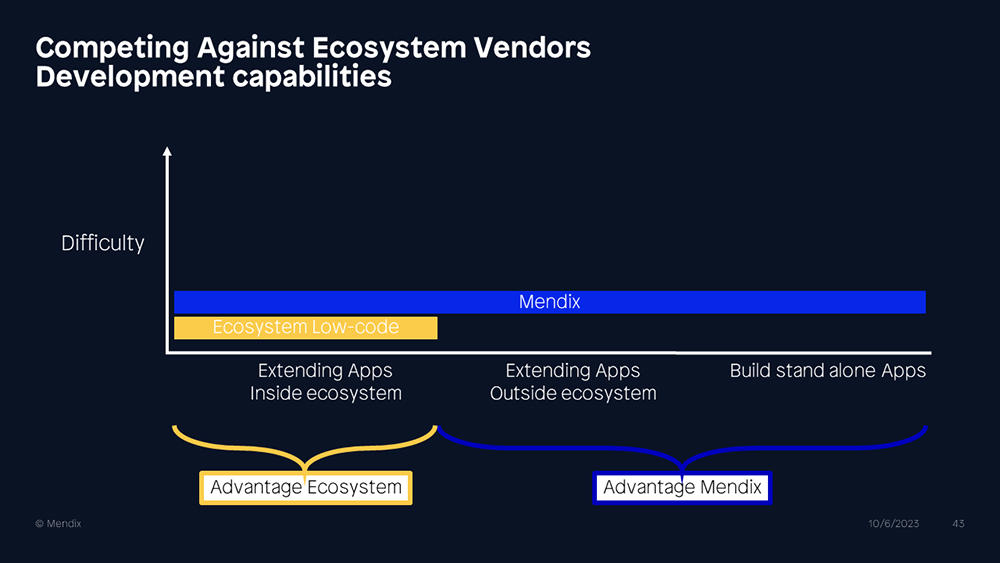
競合との比較
Danny:
Mendixと競合プラットフォームの違いについてもご説明します。
まずMendixには、競合にはないバージョンコントロールが組み込まれています。開発者が他者と協業する際には、変更のトラッキングが不可欠であるため、これは大きな強みだと言えます。なお、幅広く使われているGitをサポートしています。
またMendixはクラウドネイティブであり、マイクロサービスの量産を念頭に置いています。そのため、アップグレードもリリースも個別対応が可能です。一方、アプリケーション全体が絡み合っているアーキテクチャーを活用している競合プラットフォームの場合は、何かをアップグレードする際にすべてに反映させなければならないでしょう。
毎月新しいフィーチャー(機能)をリリースすると同時に、安全性も重視し、長くサポートできる安定したバージョンを提供していることも、Mendixの特長です。1年に1回のリリースなど頻度が低い場合は、毎回大幅な変更が加わることになります。すると、ユーザーはマニュアル操作でアプリケーションの困難なビルディングを要求されてしまいます。
モバイル対応も、開発においては非常に重要な要素です。Mendixは非常に幅広く使われている、React Nativeでモバイル開発できます。
Siemensという、長きにわたって世の中を良くするというミッションを掲げた企業がパートナーでいてくれることも、私たちの誇りです。
MendixとSAPの関係性
SAP化に伴うアドオン領域での活用
Tarig:
私からは、MendixとSAPのトランスフォーメーションについてお話をします。
私たちは2016年から「SAPの戦略的なテクノロジックパートナー」の称号をいただいています。そしてメンディックスとSAPでは、エンジニアがOデータやバピーコネクターのロードマップを一緒に作成しています。
プリンシパル伝送を利用すれば、SAPのシステムとMendixアプリケーションのセキュリティをしっかり担保したうえでデプロイメントができ、Hanaのデータベースにもリアルタイムでアプリケーションを構築できます。またエンジニアが開発者に対して、見た目も含めたエクスペリエンスを提供したいという要望もあるため、Fioriのテンプレートも提供しています。
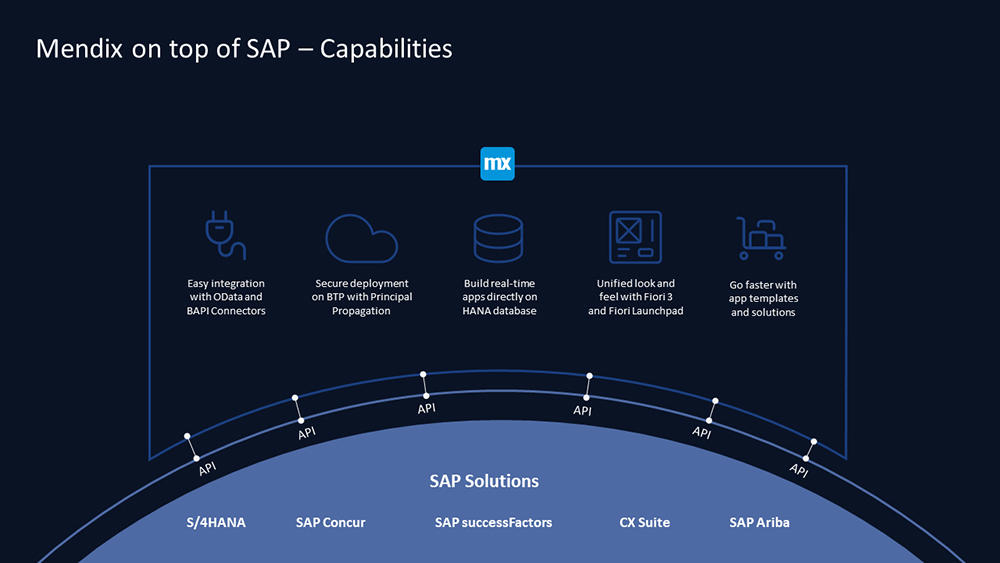
SAPがMendixのパートナーでいてくれる理由は、「コアの部分をクリーンな状態でもっていてほしい」という思いがあるからです。過去20~30年を振り返ってみても、SAPのユーザーエクスペリエンスはECCやR2のインスタンスといった、いわゆるレガシーのシステムに対する、過度のカスタマイズでした。これでは組織全体のリスクが高くなりますし、アップグレードも難しくなります。
私たちはマーケットプレースで、SAPを使っていくためのアクセラレーターを提供しています。私たちのところには30万人を超えるMendixの開発者がいるため、マーケットプレイスではリッチなコンテンツを安く提供しており、それをダウンロードしていただくことで、積極的に開発をしていただくようにしています。一例としては、「モバイル相互管理」のようなテンプレートをご用意しています。
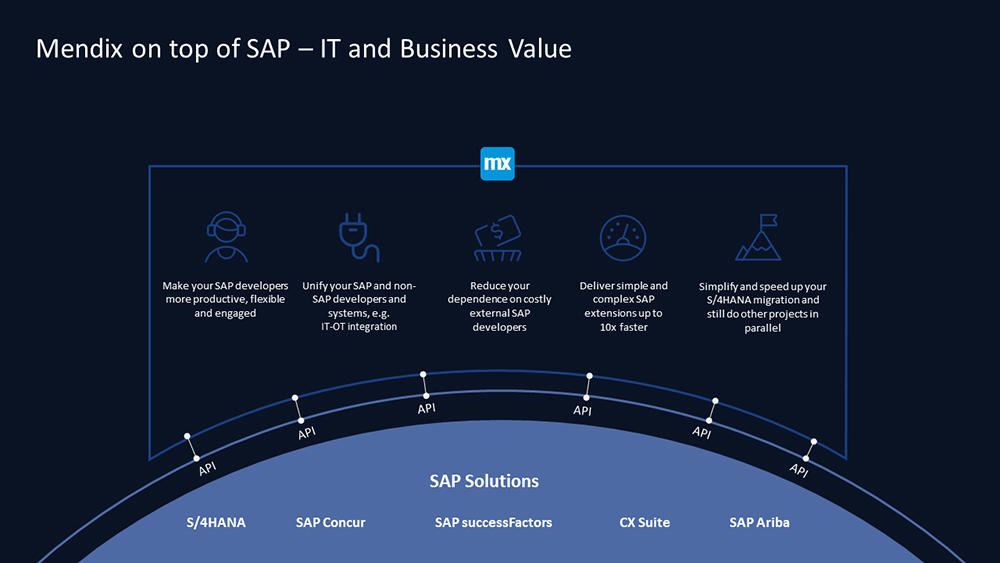
こちらのスライドには、私たちがお客様に提供しているバリューを記載しています。たとえば一番左側は「開発者の生産性を高める」といった内容です。Mendix全般で言えばもちろんビジネスサイドとITサイドの両方が対象となるのですが、この文脈においては、主にITサイドの生産性が、10倍高まると言っています。
日本も含めたリージョンのCIOからは、SAPのコンサルタントができる人材を見つけてくることが非常に難しいとよく言われています。仮に見つかっても、ABAPあるいはFioriの、そういったエクステンションを段に構築させるという意味では、人材としてはコストが非常に高いとよく聞きます。
Mendixは色々なフィーチャー(機能)の提供により、お客様のビジネスをよりスピーディにしており、非常に幅広い業界にご活用いただいています。SAPというコアをエクステンドするためのユースケースが、Mendixでもよく実現されています。
SAPの事例
Tarig:
ここからは、私たちのお客様における事例をお話します。
1つ目は、オランダで農業経営をしているCosun様です。こちらでは1989年からR2のインスタンスを使っており、ECDスタンス上に600ものカスタマイゼーションをされていました。しかし、開発の努力と適切なコンサルティングにより、半分以下の250まで絞ることができたのです。
さらに、2年半で15のMendixのアプリケーション構築にも成功しました。結果、このお客様の開発スピードは従来の7倍になり、売上の大幅な増加やコスト削減、オペレーションの効率化などが実現しました。なお特にインパクトが大きかったのは、主に調達を行う際の承認をもらうためのアプリケーションでした。また、色々なモバイルメンテナンスも行っていました。
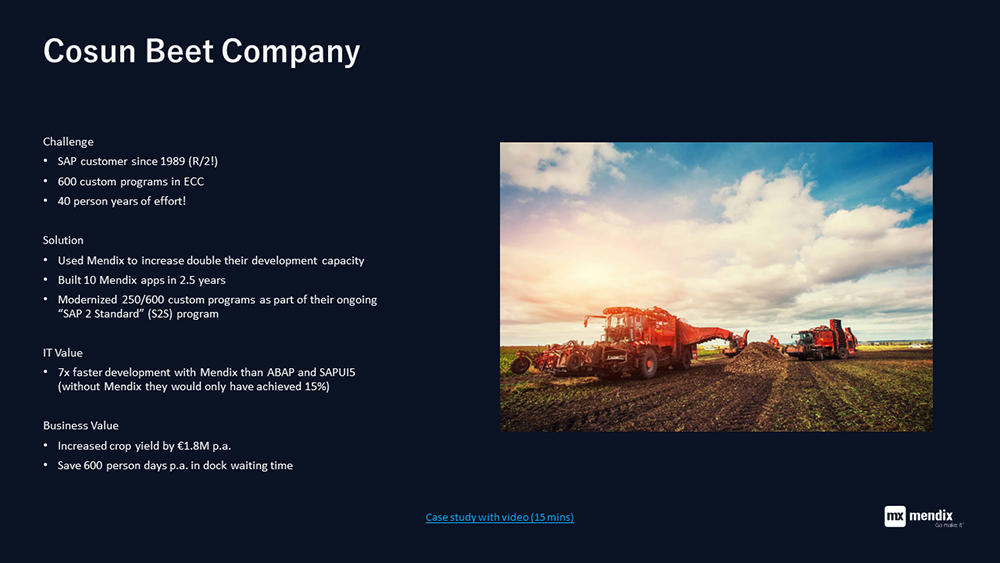
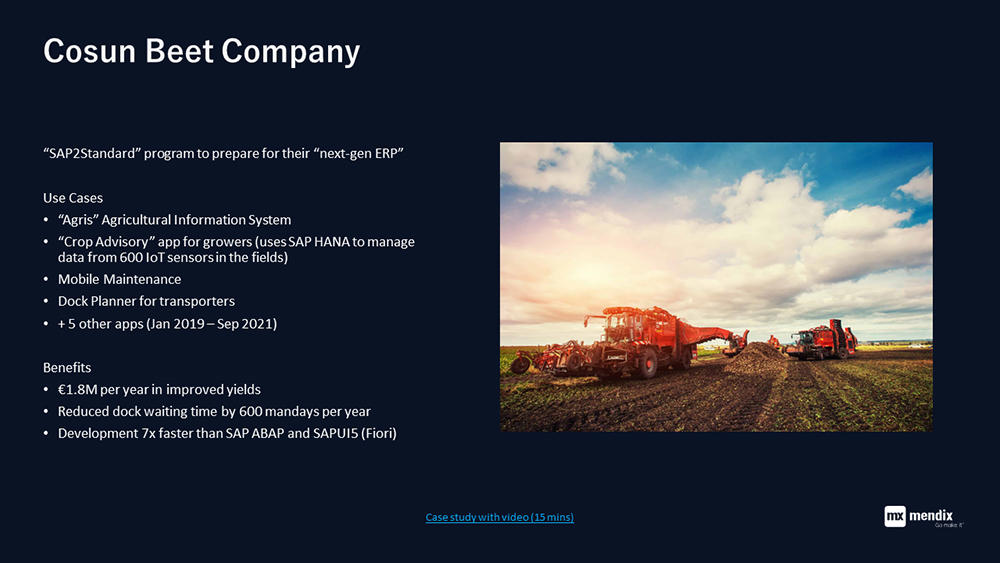
2つ目は、マイニングの企業であるSIBELCO様です。こちらはMendixの導入から5年間の間に実現したアプリケーション構築のスピードアップや、質の向上レベルが非常に高く、私たちにとっても重要なユースケースとなっています。
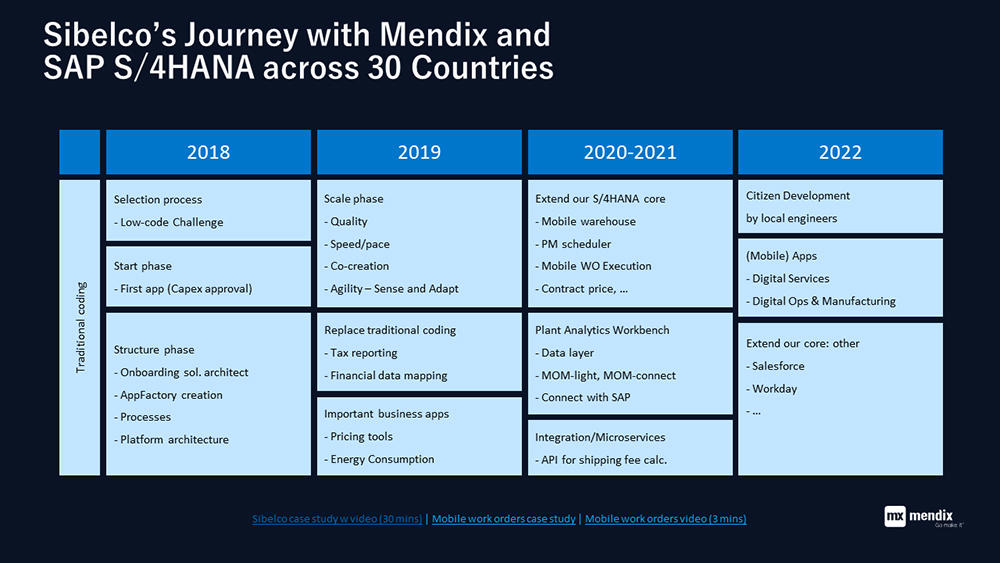
その5年間の取り組みを具体的に示したのが、こちらのスライドです。最初はスモールスタートでプラクティスを構築し、従来の複雑なユースケースやコードをリプレイスしました。そこからSIBELCO様は、非常に早いスピードでのスケーリングを実現されました。
先ほどDannyも言っていましたが、たとえばCRMやERPなどに繋ぐ必要のある複雑性の高いものを構築する場合、いわゆるエコシステムベンダーによる対応は難しくなります。その点を迅速かつ的確にクリアできたのは、Mendixのメリットであったと言えます。
こちらのお客様は、30科目でこのシステムを展開しており、それがバリューだと言えます。もっとも大きなものとしては、コアをクリーンなままに保つことができるようになったことが挙げられます。またITにスピードとアジリティを実現できるようになり、ビジネスサイドとITサイドのコラボレーションのスピードが向上しました。
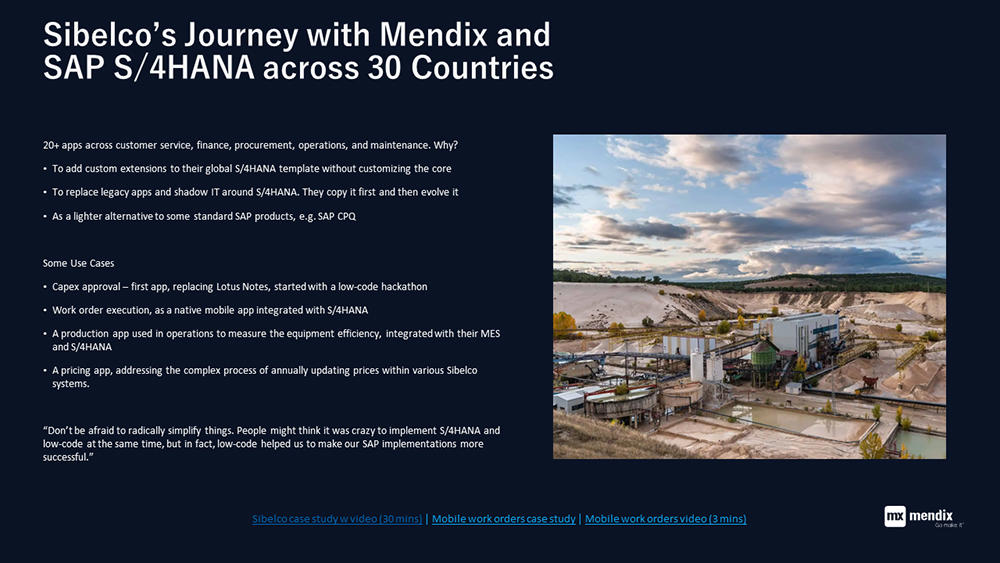
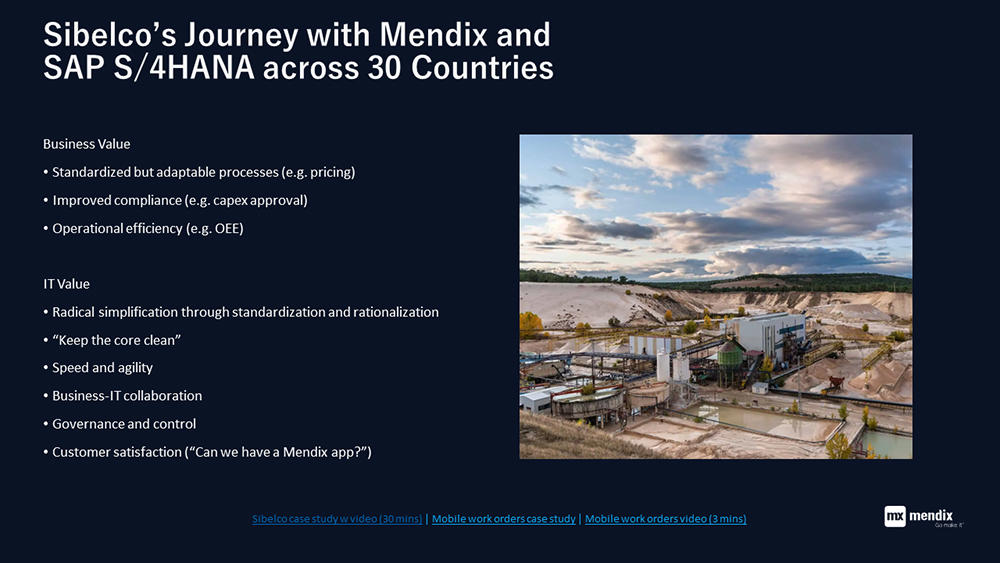
アプリケーション開発の体制とプロセス
Tarig:
私たちの理念は、プロジェクトを成功に導くために、とにかくビジネスサイドとITサイドのギャップを埋めることです。先ほどの事例でお見せしたように、複雑なエンタープライズアプリケーションを作っていく上では、やはりチームが必要です。そして、そのチームの柱にはガバナンス・ローカルのケイパビリティ・ベストプラクティス・コンポーザビリティなどの要素も欠かせません。こういった部分をしっかりと確立できれば、プロジェクトは加速的にスケールします。
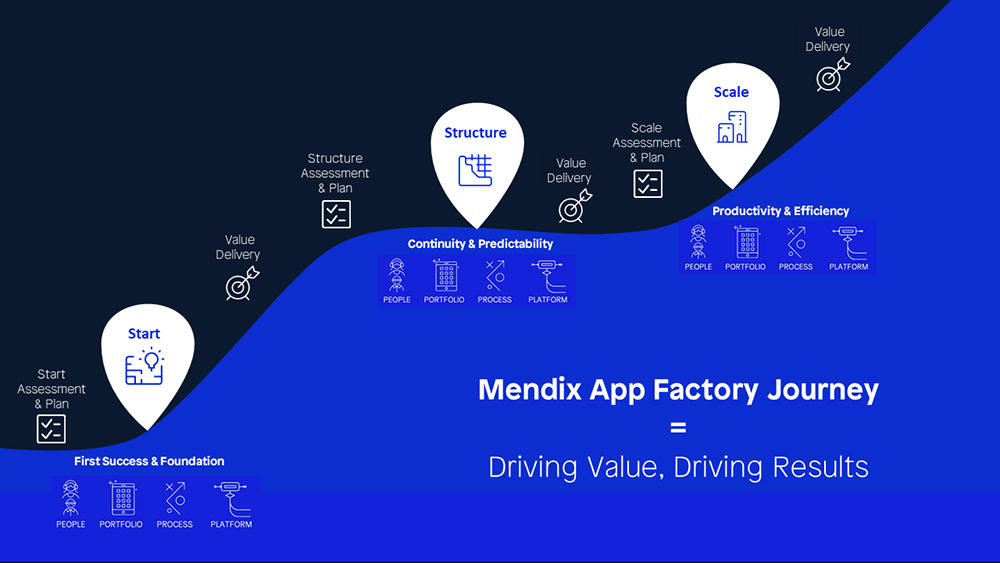
また、Start・Staructure・Scaleという「3つのS」もポイントです。Mendixを活用して開発に着手していただいた場合、最終的には1年間に25以上のアプリケーションをMendixで作れるぐらいまでスケールすることが目標となります。
私たちはジャーニーのタイムラインを通じ、People・Portfolio・Process・Platformという「4つのP」を常に念頭に置いています。プロジェクトの進行中は一貫して検証を行い、必要に応じて調整をします。そしてお客様とジョイントでKPIを入念に作成し、経過を観察します。
4つのPについても解説します。1つ目のPeopleはお客様の人材やリソースに加え、パートナーの人員などでさらに補強していくという意味です。2つ目の Portfolioは、Mendixを使うユースケースを指します。
3つ目のProcessについてはカスタマージャーニーの段階にもよりますが、我々はアジャイルカットスケールを提唱しています。4つ目の Platformは、Mendixのことを指します。具体的に言うと、コアシステムとMendixをインテグレーションしたという意味でのプラットフォームになります。これはテクノロジーという意味でのインテグレーションです。
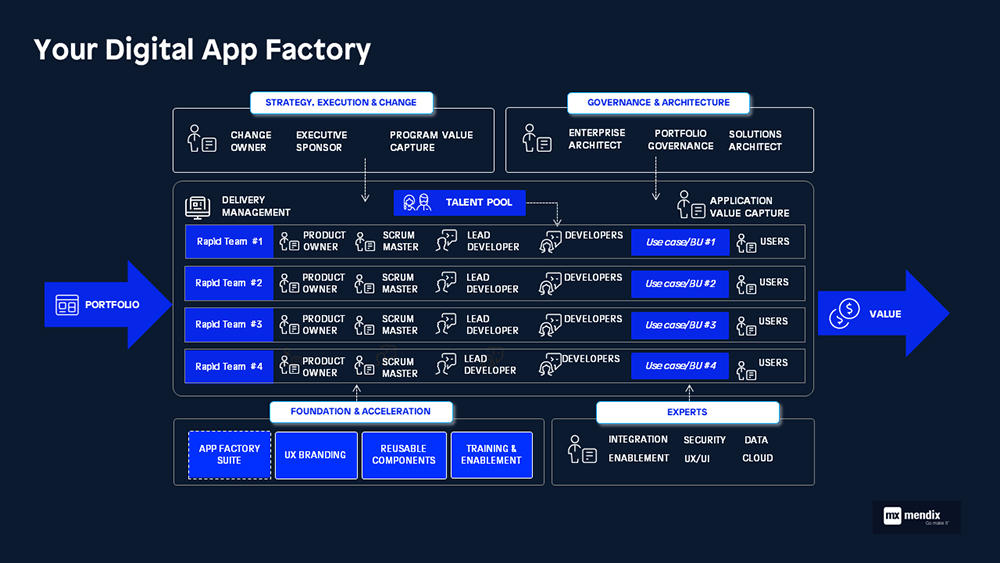
こちらは私たちが提唱する、App Factoryというメソッドです。たいていの場合、1~3つぐらいのユースケースから始めるという規模感です。図で示しているように、組織の中では、各ロールの担当者を特定することが重要です。
担当領域は人材の所属によって異なり、ITサイドであればプロダクトオーナーかユーザー、ビジネスサイドであれば要件の管理・開発者に対しての要件説明・開発者が作ったものの検証を行うことが多いです。
ただしビジネスサイドの人たちは、それ以外のタスクと並行して関わることも少なくありません。そのため、プロセス全般においてITサイドのやり取りはできるだけ圧縮しつつも、多くのインパクトを作れるような設計にしています。
必要な人員が固まったら、今度は先ほどの図でいうところの上下からチームをサポートしていきます。たとえば図の右下部分は、さまざまな領域のエキスパートが必要に応じて関与し、チームを支えることを示しています。
とりわけプロジェクトの初期段階では、私たちがもっている20年来の知見やノウハウを、大いに活用していただきます。やがて最初に結成したチームの人員は経験を積んで成熟し、バリューを生み出します。そこからはプロジェクトが加速的に進み、2つ目のチーム、3つ目のチームにそれが拡大していくのです。
このような流れを作り出せれば、Mendixを使うバリューがより濃く出てきます。初期はプロジェクトベースのマインドセットですので色々な制限もありますし、規模が小さいです。しかしプロジェクトが真の意味でスケールしてくると、年間150本以上のアプリケーションを開発することも不可能ではありません。
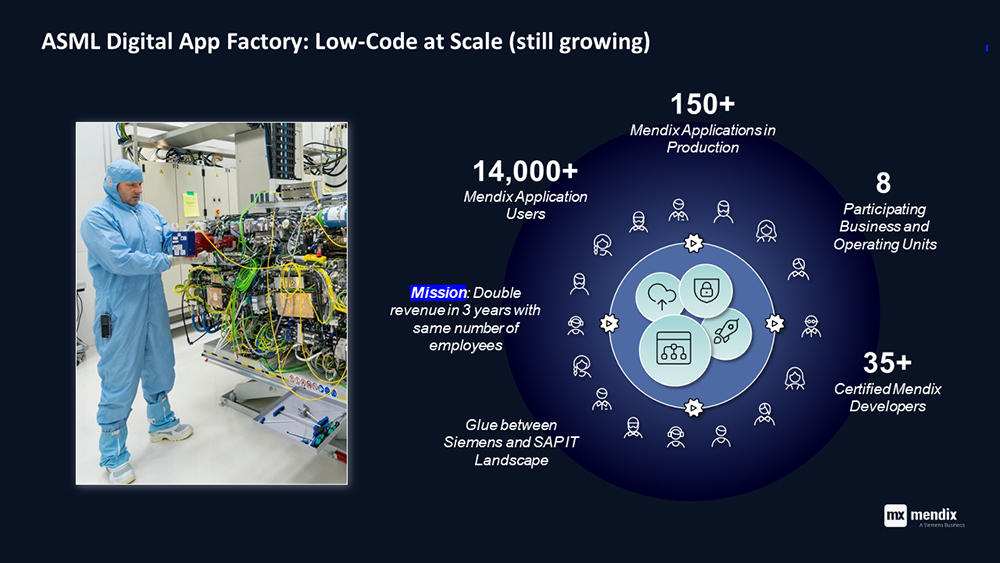
その数字を実現したのが、オランダで半導体機器を制作している企業のASML様です。同社には、「3年間で会社全体の売り上げを倍増せよ」というミッションが与えられていました。このミッションの達成のためであれば、Mendixへの投資額は非常に小さいと言えるでしょう。なお、ASML様ではエンドユーザーの数も14,000と、非常に多いことが特徴です。
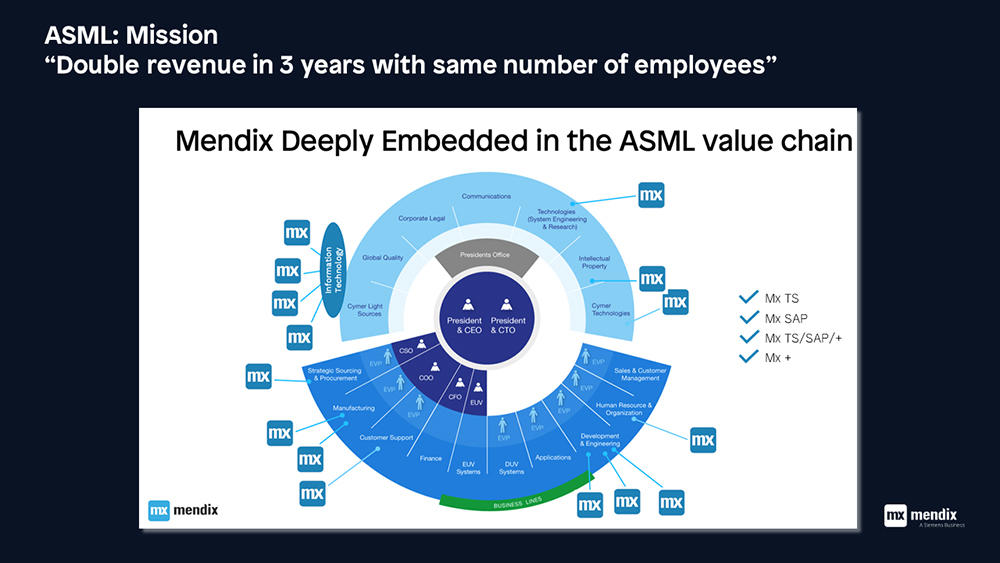
こちらはASML様の社内で、Mendixがどの部門で実装されてるかを表した図です。同社における最初の導入は、エンジニアリング部門からでした。そして、この部門での取り組みが成功して成熟するにつれ、ビジネスサイドも「我々の部門もMendixでアプリケーションを作ろう」と、Mendixの価値を認識し始めました。やがてこの流れは、HR・リーガル・マニュファクチャリングに伝わっていきました。ASML様は、まさにMendixの真のバリューが実現したお客様であると言えるでしょう。
まとめ
今回は、Siemens社のDanny氏とTarig氏に、Mendixの強みや活用事例などを語っていただきました。
今回のディスカッションでは、Mendixが世界的にポピュラーであり、さまざまな業界で大幅な業務効率の改善に貢献しているプラットフォームということを再確認できました。また、その利用範囲が開発者をはじめとしたITサイドにとどまらず、営業などのビジネスサイドのチームにも波及している事実も、Mendixの利便性を如実に示していると言えます。
加速する社会環境の変化に適応するには、スピード感のある業務改革が欠かせません。Mendixは、その実現に向けた心強い味方になってくれることでしょう。
ビジネスの環境変化に対応できる組織をつくるために!
マクニカは、お客様の DX 開発体制強化や人材育成をサポートしています。
